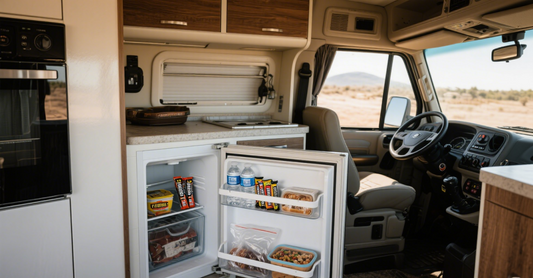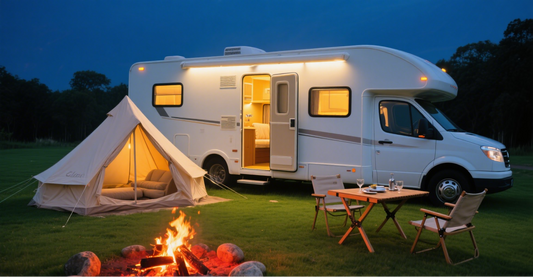How Long Will a 100Ah Deep Cycle Battery Run a 12V Fridge?
When camping outdoors or traveling long distances in a cabin, it is essential to use a 12V refrigerator to keep food and beverages fresh. Therefore, how long can a 100Ah deep-cycle battery power a 12V refrigerator? This article will explore the factors that affect battery runtime and provide tips for maximizing efficiency to ensure your outdoor trip has a continuous power supply.


Understanding 12V 100Ah Deep Cycle Lithium Batteries
A 12V 100Ah deep cycle battery is designed to deliver steady power over extended periods, making it ideal for running a 12V fridge.
The term Ah (ampere-hours) measures capacity, indicating how much current a battery can supply. For example, a 12V 100Ah lithium battery can theoretically provide 100 amps for one hour or 10 amps for 10 hours.
Unlike traditional lead-acid batteries, which offer only about 50% usable capacity, a deep cycle lithium battery provides 80-100% usable capacity, consistent voltage, and a lifespan exceeding 3,000 charge cycles.
Built-in Battery Management System (BMS) protects lithium batteries from overcharging, deep discharging, and overheating, enhancing safety and longevity. These qualities make lithium batteries a reliable choice for off-grid refrigeration, ensuring efficient power usage for your fridge.
Factors Affecting How Long a 100Ah Battery Can Run a 12V Fridge
Several variables determine how long a 100Ah lithium battery can run a 12V fridge, directly impacting battery life.
- Fridge's Power Consumption: This ranges from 20-50W across models. Higher power consumption shortens runtime. For example, a 50W fridge uses more power than a 20W model, reducing a 100Ah battery's runtime from ~3 days to ~1.5 days at a 40% duty cycle.
- Fridge Compressor Duty Cycle: The fridge compressor cycles on and off, typically active 20-50% of the time, based on insulation and contents. A higher duty cycle increases power usage, shortening runtime. A 30L fridge may run at 20-30% in mild weather (e.g., 70°F/21°C), while a 50L model may hit 40-50% in heat, cutting runtime by ~1 day.
- Ambient Temperature: Hot climates (e.g., 90°F/32°C) make the compressor work harder, raising the duty cycle by 10-15% and adding ~50-100Wh/day, which can reduce runtime by 0.5-1 day. In cold climates (e.g., 32°F/0°C), a 15-20% duty cycle extends runtime by ~0.5 days.
- Battery Efficiency: Temgo Lithium batteries offer 80-100% usable capacity, unlike traditional lead-acid batteries (50%), extending runtime.
- Inverter Efficiency: For AC fridges, inverters (80-95% efficient) increase power draw. Lower efficiency (e.g., 80%) shortens runtime by ~10-15% compared to 95% efficiency inverters.
- Battery Condition: Older batteries lose capacity, reducing runtime slightly (e.g., 5-10% after 1,000 cycles).
This table compares battery types, highlighting lithium's efficiency and faster charging for fridge applications. These factors help you estimate the duty cycle and power needs, ensuring accurate planning for your fridge's operation.
| Battery Type | Usable Capacity | Lifespan (Cycles) | Weight (Approx.) | Charge Efficiency |
|---|---|---|---|---|
| Lithium (LiFePO4) | 80–100% | 2,000–4,000 | 25–30 lbs | 95–99% |
| Lead-Acid (AGM) | 50% | 200–500 | 60–70 lbs | 80–85% |
| Gel | 50% | 500–700 | 65–75 lbs | 80–85% |
How to Calculate Runtime for a 12V Fridge
To estimate how long a 100Ah deep cycle lithium battery can run a 12V fridge, follow these simple steps to calculate the fridge's power consumption and battery life. Think of the battery as a water tank: its capacity (amp-hours) determines how much power it holds, and the fridge's usage drains it at different rates.
- Determine Fridge Power Usage: Check the fridge's label for its power rating, measured in watts (W). For example, a 40W fridge running 24 hours a day would use 40W × 24h = 960Wh. Since the fridge compressor only runs part-time (called the duty cycle, typically 20-50%), adjust for this. A 40% duty cycle means it runs 40% of the time:
960Wh × 0.4 = 384Wh/day
- Convert Watt-Hours to Amp-Hours: Convert the fridge's power usage to amp-hours (Ah) by dividing daily watt-hours (Wh) by the battery's voltage (12.8V for LiFePO4):
384Wh ÷ 12.8V = 30Ah/day
If using an AC fridge with an inverter (e.g., 85% efficient), account for energy loss: 30Ah ÷ 0.85 ≈ 35.3Ah/day.
- Calculate Runtime: Divide usable capacity by daily usage:
100Ah ÷ 35.3Ah/day ≈ 2.8 days
For a 30W fridge at 20% duty cycle (e.g., in cold weather), it's 144Wh/day (30W × 24h × 0.2) ÷ 12.8V = 11.3Ah/day, yielding ~7 days.
- Use this formula for quick estimates:
Runtime (days) = (100Ah × 12.8V) ÷ (Fridge Watts × Duty Cycle × 24h ÷ Inverter Efficiency).
You can also use the Temgo RV Calculator tool to help you obtain a customized battery solution selection.
How to Tips to Maximize Battery Life and Fridge Efficiency
To extend how long your 100Ah lithium battery can run a 12V fridge, consider these practical strategies, these tips reduce the fridge's power consumption and ensure efficient use of your battery's capacity.
- Keep the Fridge Full: A full fridge minimizes air circulation, reducing the compressor's workload and power usage.
- Pre-Cool Items: Chill food and drinks in a home fridge before placing them in the 12V fridge to lower cooling demands.
- Optimize Temperature Settings: Set the fridge to 35-38°F (2-3°C) to maintain freshness without overcooling.
- Minimize Door Openings: Limit openings to reduce compressor cycling and conserve power.
- Improve Insulation: Use an insulated cover or park in shaded areas to counter ambient temperature effects. For marine users, ensure the fridge is shielded from saltwater exposure to maintain insulation efficiency.
- Use Solar Panels or AC Charging: Recharge with a 150-200W solar panel (e.g., 10-12 hours to full charge with a 30A MPPT controller) or AC power to extend runtime. A 150W panel with a 30A MPPT controller can deliver ~50Ah/day in sunny conditions, sufficient to recharge a 100Ah battery daily.
- Maintain Battery Health: Avoid full discharges, store at 50-60% charge in 50-77°F (10-25°C), and check BMS alerts for issues. Regularly inspect terminals for corrosion and cycle the battery every 3-6 months during storage to maintain capacity.
Conclusion
A 100Ah deep cycle lithium battery can run a 12V fridge for approximately 1.8-2.8 days, depending on the fridge's power consumption, duty cycle, inverter efficiency, and ambient temperature. By learning to convert watt-hours to amp-hours and applying energy-saving tips, you can maximize battery life for reliable refrigeration during long trips or off-grid adventures.
For a dependable power solution, Temgo 12V 100Ah lithium batteries are engineered for reliability, with features like advanced BMS for overcharge and temperature protection and up to 4,000 cycles, ideal for RV camping, marine, or off-grid setups.


